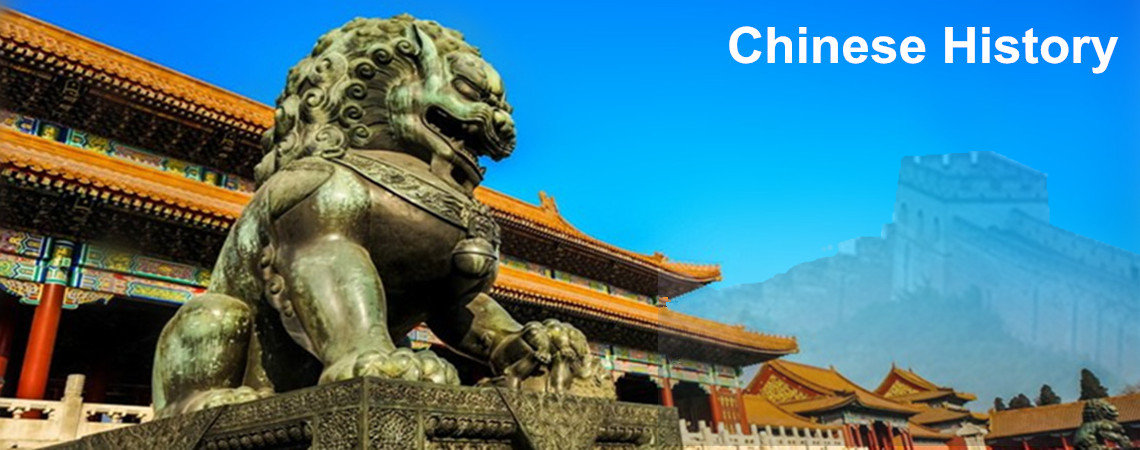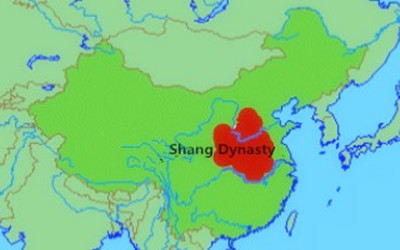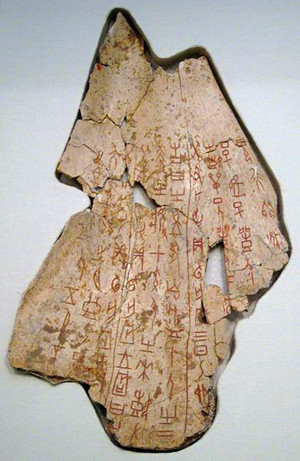
Shang (1766BC-1027BC)
Time: (1766 B.C.-1122 B.C.)
Location of Capital: Modern City of Anyang in Henan Province
Emperors: Tang,...Zhou 30 emperors
Replaced by: Zhou Dynasty
Brief Introduction to Shang Dynasty
 Shang Dynasty (c.1766-1046 BCE) was the second dynasty of China which succeeded Xia Dynasty (c. 2700-1766 BCE) after the overthrow of the Xia tyrant Jie by Tang , the Shang leader. In 1766 BC, Tang, the leader of the Shang tribe, overthrew the sovereign of the Xia Dynasty, and established the Shang Dynasty. Tang made Bo (Shangqiu City, Hennan Province today) the new capital. Learning a lesson from the tyrant Jie, the last emperor of the Xia Dynasty, King Tang became well-known as an emperor who governed his people with benevolence and compassion. Tang was diligent in state politics, kind to the common people, and paid attention to developing agricultural production. Tang conducted punitive expeditions against all sides, and expanded his territory into the Di and Qiang peoples' territory in the west. Under Tang's rule, the country prospered, society developed quickly.
Shang Dynasty (c.1766-1046 BCE) was the second dynasty of China which succeeded Xia Dynasty (c. 2700-1766 BCE) after the overthrow of the Xia tyrant Jie by Tang , the Shang leader. In 1766 BC, Tang, the leader of the Shang tribe, overthrew the sovereign of the Xia Dynasty, and established the Shang Dynasty. Tang made Bo (Shangqiu City, Hennan Province today) the new capital. Learning a lesson from the tyrant Jie, the last emperor of the Xia Dynasty, King Tang became well-known as an emperor who governed his people with benevolence and compassion. Tang was diligent in state politics, kind to the common people, and paid attention to developing agricultural production. Tang conducted punitive expeditions against all sides, and expanded his territory into the Di and Qiang peoples' territory in the west. Under Tang's rule, the country prospered, society developed quickly.From the rule of King Tang to King Taiwu, the ninth emperor, the Shang Dynasty went through a consolidating and developing period. Although there were fatuous kings and struggles within the royal family, the Shang Dynasty maintained its rule with the help of some wise and loyal ministers.
However, from the tenth emperor – Zhongding, chaos prevailed in the royal family. During the rule of the following nine kings after Zhongding, multiple struggles took place for the crown between brothers or uncles and nephews, and the capital was moved more than once. The Shang Dynasty was surrounded by enemies. Social problems began to emerge; the country began to fall into decay; vassals didn't go to the court any more. To overcome the crisis, Pangeng, the twentieth emperor, moved the capital to Yin (Xiaotun Village in Anyang City, Henan Province today). Then, Pangeng practiced King Tang's policies, and carried out a series of reforms. He got rid of the vice of extravagance, and took care of the lives of the common people, which helped to stabilize the situation to some extent. As a result, the social politics, economy and culture recovered and developed. This event is called 'Pangeng when the capital was moved to Yin' historically.
Emperor Wuding, the 22nd king of the Shang Dynasty, grew up in the country, so he knew the hardships and sufferings of the common people. After ascending to the throne, he appointed people on their merits, was cautious and attentive with state affairs, and pacified the invasions of the nomadic peoples. By doing so, he consolidated his rein on one hand, and enlarged the territory on the other. During Wuding's rule, the Shang Dynasty reached it's peak. At that time, its territory extended to Liaoning Province in the north, covered Hubei Province in the south, got to Shaanxi Province in the west, and was on the sea in the east.
Cultural relics from Wuding's reign are very rich, including palaces, tombs and workshops. Besides, breakthrough progress has been made in bronze making. Alloy blended with copper, tin, and lead appeared, and Simuwu Rectangle Ding and Twin Rectangular Yi were just made then. Meanwhile, great achievements were made in spinning, medicine, transportation, and astronomy. While, the grand occasion Wuding inaugurated didn't last long after his death. Since Zujia, the 24th emperor, social contradictions increased, and Shang Dynasty gradually declined. To the rule of Zhou, the Last emperor of the Shang Dynasty, struggles between the royal family and the nobles developed to the zenith. Facing the serious situation, King Zhou didn't think of the resolutions, didn't take the good advice of the loyal ministers; he just pursued an extravagant and dissipated life all day long; he assembled forces to crusade against the eastern tributaries. What he did embittered the people, made the nation's coffers empty, and intensified the discontent within the country.
Seizing the opportunity, the Zhou State, a Vassal State in the West, staged an uprising to overthrow King Zhou's tyrannical sovereignty. Emperor Zhou didn't organize forces to fight the battle until King Wu of the Zhou State's army reached Muye, the suburban area of the Shang Dynasty's capital. Finally, King Zhou burned himself to death in despair ending the Shang Dynasty.
Political History of the Shang Dynasty
The Shang Dynasty (Chinese: 商朝) or Yin Dynasty (殷代) was, according to traditional sources, the second Chinese dynasty, after the Xia Dynasty. They ruled in the northeastern regions of the area known as "China proper", in the Yellow River valley.
According to the chronology based upon calculations by Liu Xin, the Shang ruled between 1766 BC and 1122 BC, however according to the chronology based upon the Bamboo Annals, it is between 1556 BC and 1046 BC. The results of the Xia Shang Zhou Chronology Project places them between 1600 BC and 1046 BC. According to historical tradition the Shang Dynasty followed the (possibly mythical) Xia Dynasty and preceded the Zhou Dynasty.
 Direct information about the Shang Dynasty comes from Shang inscriptions on bronze artifacts, but mainly from oracle bones—turtle shells, cattle scapulae or bones on which were written the first significant corpus of recorded Chinese characters. Other sources on the Shang come from historical records of the later Zhou Dynasty and the Han Dynasty Shiji by Sima Qian. The inscriptions on the oracle bones are divinations, which can be gleaned for information on the politics, economy, culture, religion, geography, astronomy, calendar, art and medicine of the period, and as such provide critical insight into the early stages of the Chinese civilization.
Direct information about the Shang Dynasty comes from Shang inscriptions on bronze artifacts, but mainly from oracle bones—turtle shells, cattle scapulae or bones on which were written the first significant corpus of recorded Chinese characters. Other sources on the Shang come from historical records of the later Zhou Dynasty and the Han Dynasty Shiji by Sima Qian. The inscriptions on the oracle bones are divinations, which can be gleaned for information on the politics, economy, culture, religion, geography, astronomy, calendar, art and medicine of the period, and as such provide critical insight into the early stages of the Chinese civilization.
One site of the Shang capitals, later historically called the Ruins of Yin (殷墟), is near modern day Anyang. Archaeological work there uncovered 11 major Yin royal tombs and the foundations of palaces and ritual sites, containing weapons of war and remains of animal and human sacrifices. Tens of thousands of bronze, jade, stone, bone and ceramic artifacts have been obtained; the workmanship on the bronzes attests to a high level of civilization. In terms of inscribed oracle bones alone, more than 20,000 were discovered in the initial scientific excavations in the 1920s to 1930s, and over four times as many have since been found.
Economy and Culture
Agriculture was the main production department of Shang Dynasty, and the main crops then included millet, wheat, rice, mulberry, and hemp. Handicraft industry of Shang Dynasty run by the feudal official was also flourishing. Bronze making was the symbol of the Shang civilization. In addition to Simuwu Rectangle Ding, Four Goats Quadripod was also a fine bronze object of the Shang Dynasty. Large-scale workshops produced all kinds of handicrafts containing high-level techniques. Besides, people of the Shang Dynasty invented the primitive porcelain, and improved the techniques of making pottery and jade objects. In spinning, people had mastered the skill of jacquard weaving, producing tabby gauze and leno. Merchants engaging in all kinds of businesses appeared in the cities during the last period of the Shang Dynasty.
In the Shang Dynasty, folk music and palace music both made marked progress. The Shang Dynasty also includes the way they write. Along with the rise of the bronze smelting technique, a large number of fine musical instruments were made. People engaging in music were divided into three categories - 'Wu', music slavery, and 'Gu'.
They usually write with a special formula of ink. The characters then were various, including hieroglyphics, semasiographies phonograms, phonetic loan characters, and self-explanatory characters. These characters were carved on animal bones or tortoise shells named 'inscriptions on oracle bones', which was one of the most ancient written languages in the world. The characters inscribed on bones and shells were in square shapes because the carving materials were hard; while the 'inscriptions on bronze objects' which were cast were round in shape.
Science In the Shang Dynasty
In astronomy, the Shang Dynasty produced the calendar on the cycle of the moon. The calendar of the Shang Dynasty was differentiated into big and small months, and it regulated that 366 days formed a cycle. Besides, in the 'inscriptions on oracle bones' of the Shang Dynasty, there are many records about solar eclipse, lunar eclipse and nova.
In mathematics, there are big numbers up to thirty thousand and specific conceptions about decimal system, odd numbers, even numbers and multiple numbers, according to the 'inscriptions on oracle bones'. It indicates that people of that time had preliminary capability of calculating.
Additionally, optics knowledge was also used then. The excavated convex mirror of the Shang Dynasty can mirror the whole face of a person completely.







 Ask Questions ?
Ask Questions ?